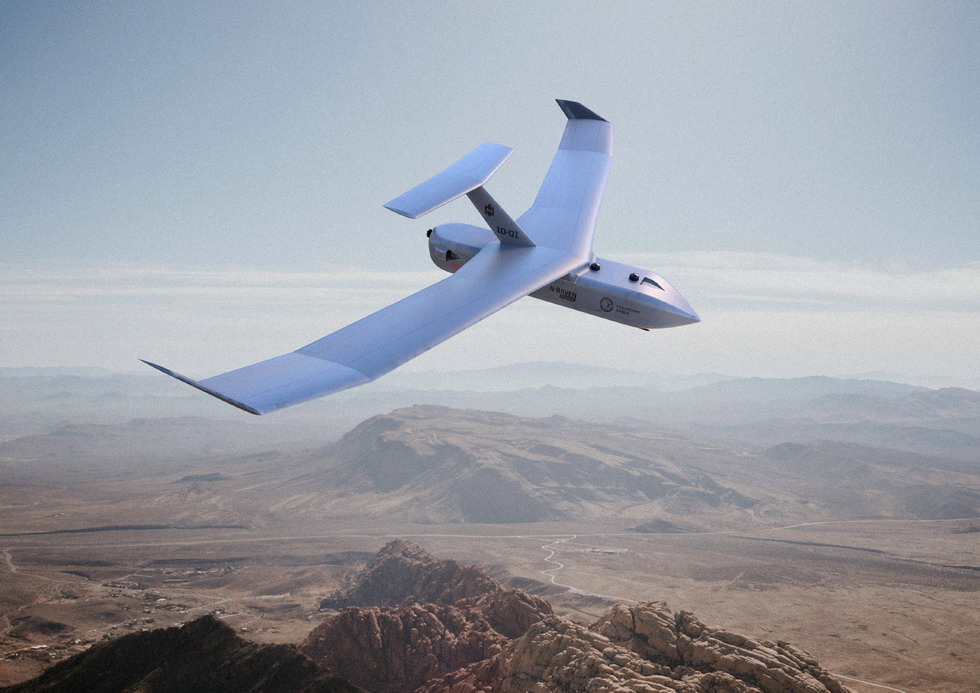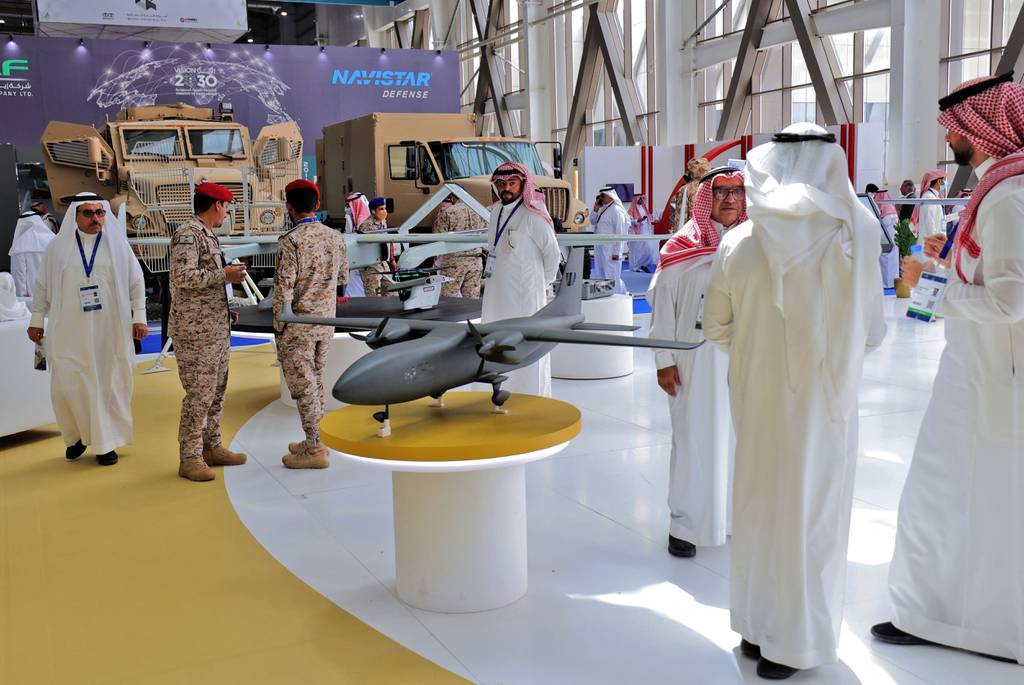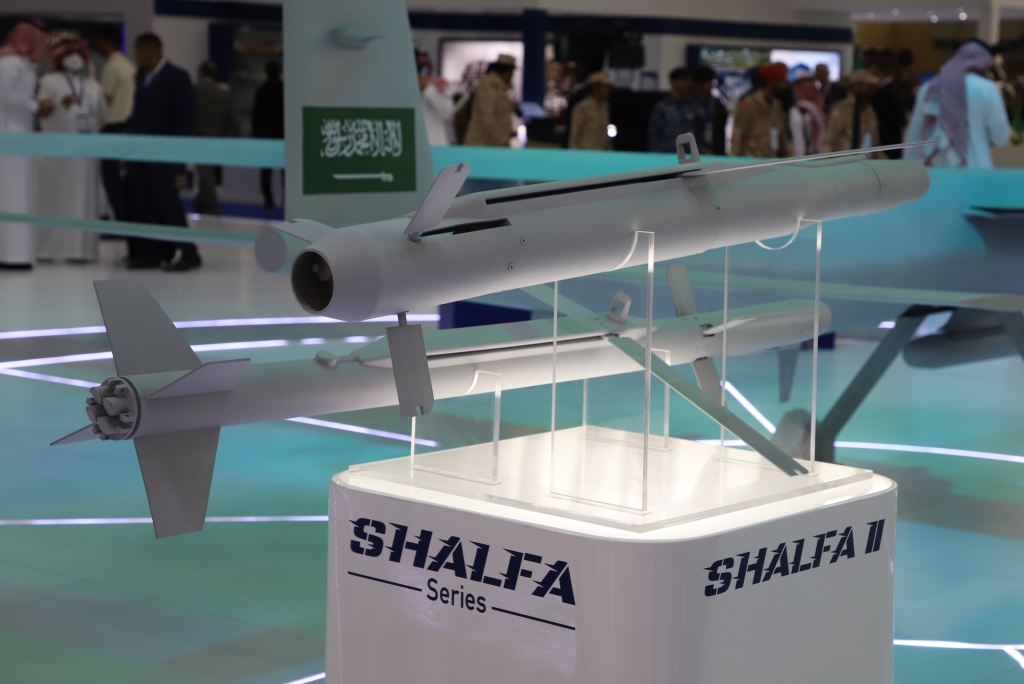We don't really know for sure. Let me give you an example why that is.
Chinese and Saudi firms create joint venture to make military drones in the kingdom
By Agnes Helou
Wednesday, Mar 9 2022
Military drones are displayed at Saudi Arabia's first World Defense Show on March 8, 2022. (Fayez Nureldine/AFP via Getty Images)
BEIRUT — Saudi and Chinese industry have joined forces to design and build military drones in the kingdom.
Advanced Communications and Electronics Systems Co. signed an agreement with China Electronics Technology Group Corp., with the two companies announcing their tie-up during the
World Defense Show in Riyadh, which took place March 6-9.
The joint venture, named Aerial Solutions, will see CETC establish a research and development center and create a team that would manufacture different types of UAV systems. These are to include communications, flight-control, camera, radar and wireless-detection systems.
CETC specializes in manufacturing security electronic information systems, including electronics equipment, communication devices and software.
The new venture will also focus on developing electric-powered vertical-takeoff-and-landing drones, anti-drone solutions, analytics, helicopter products and radar systems.
Aerial Solutions aims to protect infrastructure and localize technological innovation through scientific research, manufacturing and training national engineers, according to a company statement.
ACES said on Twitter that the move is in line with
Saudi Arabia’s Vision 2030 initiative, which aims to
grow local industry.
This is not the first time China and Saudi Arabia signed a contract allowing the kingdom to procure Chinese unmanned aerial systems.
In 2017, Saudi Arabia ordered Chinese-made Wing Loong II drones. Chinese news agency Xinhua described the deal as the country’s largest-ever arms export.
China Aerospace Science and Technology Corp. also previously signed a partnership with King Abdulaziz City for Science and Technology to build a manufacturing facility in Saudi Arabia for the CH drone class.
CETC took part in the World Defense Show this year — the expo’s inaugural launch.
Other Chinese companies at the show included China North Industries Group Corp. Limited (NORINCO), China National Aero-Technology Import and Export Corp. (CATIC), Star Vision, and China Aerospace Long March International Trading Co. (ALIT).
Advanced Communications and Electronics Systems Co. signed an agreement with China Electronics Technology Group Corp., with the two companies announcing their tie-up during the World Defense Show in Riyadh.

www.defensenews.com
Article from 2017:
Behind the Chinese Drone Factory in Saudi Arabia
China is playing an increasingly bigger role in the international arms market, filling demands refused to be met by the United States. Barred from buying American drones, Saudi Arabia is diversifying its security cooperation by buying Chinese technology
Dr. Shaul Shay | 17/04/2017
View attachment 887003
When President Xi Jinping visited Riyadh in January 2016, the two countries promised to form a comprehensive strategic partnership and boost industrial cooperation in line with Beijing’s “One Belt, One Road” trade and investment initiative across Central Asia and the Middle East.
Saudi Arabia had been China's biggest supplier of imported crude oil before being overtaken by Russia last year, and the kingdom's state-owned oil producer, Aramco, is a partner with state-owned China Petroleum & Chemical Corp.
During the latest visit to China by Saudi Arabia's King Salman bin Abdulaziz Al Saud from March 15-18, 2017, the two countries signed deals worth as much as $65 billion in energy, culture, education and technology and a partnership agreement to manufacture drones.
The factory’s unmanned aerial vehicles (UAVs) will be put to
both military and civilian use in Saudi Arabia and will be
marketed to other countries in the region.
The Milestones of the "Drone Deal"
Saudi Technology Development and Investment Company (TAQNIA) had signed a protocol with China’s Aerospace Long-March International Trade (ALIT) for the drone production line at the biennial International Defense Exhibition and Conference (IDEX) in Abu Dhabi in February 2016.
TAQNIA is a subsidiary of Saudi Arabia’s Public Investment Fund, while ALIT is a Chinese export-import company that specializes in aerospace technologies.
The protocol was followed on March 16, 2016, by a partnership agreement between the King Abdulaziz City for Science and Technology (KACST), with China Aerospace Science and Technology Corporation (CASC), which makes China’s CH-4 unmanned aerial vehicle (UAV).
The CH – 4 (Rainbow 4) Drone
The CH-4 has reconnaissance and combat functions and has similar capabilities to the American Air Force’s MQ-1 Predator. The CH-4 Drone fires AR-1 missiles that can hit a distant target with a margin of error of less than 1.5 meters.
A CH-4 Drone costs US$4 million, while the US Air Force website says a package including four MQ-1 Predators and a ground control station costs US$20 million.
The CH-4 Drone is already being used by Saudi Arabia, Egypt, Iraq, Jordan and several other countries.
The Wing Loong Drone
In 2014, China had exported the Wing Loong, a medium-altitude, long-endurance UAV, which can also be fitted with missiles to Saudi Arabia. The Kingdom was the first Arab country to obtain such type of drone, which was developed by Chengdu Aircraft Industry Group.
The CASC CH-4B and CAIG Wing Loong II have similar specifications, especially in terms of payload and endurance (Wing Loong II: 400 kg and 32 hours vs. CH-4B: 345 kg and 40 hours).
Both UAV platforms can deploy China’s range of air-to-surface munitions, such as the AR-1 laser-guided missile.
Summary
China is playing an increasingly bigger role in the international arms market, filling demands refused to be met by the USA. America refuses to sell its Predator and Reaper UAVs beyond a select list of European nations, the UK being one of them. This has created a vacuum in the market, one that
China is happy to fill. Barred from buying American drones, Saudi Arabia turned to China.
While military cooperation with the US remains very important, Saudi Arabia, the world’s second-largest arms importer, actively diversifies its security cooperation, so as to maximize its flexibility in responding to threats.
In recent years, security ties between China and Saudi Arabiya have grown significantly. The two militaries held joint counter-terrorism exercises and, Chinese navy vessels have visited the Saudi port of Jeddah.
China's growing trade of drones with Saudi Arabia reflects the growing popularity of Chinese weapons, especially UAVs, on the global market, thanks to their comparatively low prices and technical advantages.
The real aims behind the deals are an oil-hungry China being able to get more oil from the kingdom to sustain its domestic economic development, and Saudi Arabia improving its infrastructure with China’s technological aid.
The factory will be China’s first in the Middle East, with drone plants already established in Pakistan, and will be overseen by a partnership between the King Adbulaziz City for Science and Technology.
Saudi Arabia already uses combat drones in its conflict with Yemen. The CH-4 factory in Saudi Arabia would help satisfy Saudi Arabia’s desire for more CH-4 drones and would also sell drones and services for clients in the Middle East.
When President Xi Jinping visited Riyadh in January 2016, the two countries promised to form a comprehensive strategic partnership and boost industrial cooperation in line with Beijing’s “One Belt, One Road” trade and investment initiative across Central Asia and the Middle East. Saudi Arabia...

www.israeldefense.co.il
So we are back to the "secrecy" thing when it comes to both KSA and China.
I don't think that we will ever know the status quo of all this until years from now on. Like with all the other deals between those two nations.








